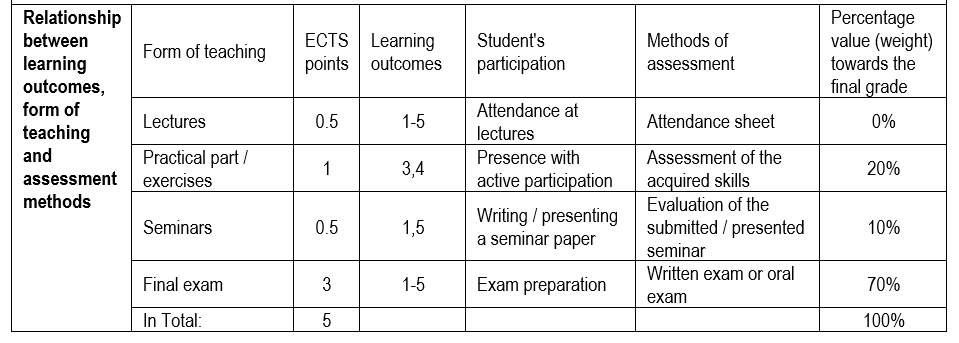In internal medicine, students of dental medicine learn about diagnostic-therapeutic important internal (internistic) diseases: their clinic, diagnostics and treatment principles.
The aim of dermatovenerology studies is the understanding and knowledge of theoretical basics of skin and sexually transmitted diseases. Students of dental medicine will understand the clinical picture of a patient with skin and sexual diseases in everyday practice. Students will be able to diagnose skin and sexually transmitted diseases in the neck and head area through clinical examination, i.e. simple diagnostic tests. They will gain knowledge of differential diagnostics of these diseases, methods of treatment, prophylaxis and their epidemiology.
Knowledge of etiopathogenesis, clinics, diagnostics and treatment principles of some internal diseases. Intensive medicine and cardiology: heart relaxation, heart rhythm disturbances, rheumatic and infectious endocarditis, acquired heart defects, ischaemic heart disease, arterial hypertension, shock and reanimation.
Angiology: atherosclerosis and vascular damage (disability), venous thrombosis.
Pulmology: bronchitis, asthma, COPD, pneumonia, respiratory tract cancer, pulmonary TB.
Gastroenterology: oesophagitis and gastritis, oesophageal tumours, upper GI peptic ulcers, ulcerative colitis and Crohn's disease, hepatitis and cirrhosis of the liver, acute holecystitis and gallstones, obstructive hepatitis.
Nephrology: acute and chronic renal failure, glomerulonephritis, nephrotic syndrome, bacterial urinary tract inflammation, urinary tract stones.
Haematology: anaemia, myelodysplastic syndrome, acute and chronic leukaemia, thrombocytopenia and drug-induced thrombocytic dysfunction, haemophilia and von Willebrand disease, coagulation disorders due to liver and drug diseases.
Rheumatology: rheumatic fever, rheumatoid arthritis, systemic lupus ertematosis, sclerodermia, Sjögren syndrome, ankylosing spondylitis.
Endocrinology: thyroid diseases, diabetes mellitus, pathophysiology and basic clinical data of other glands with internal secretion.
Dermatovenerological propedeutics, specific treatment of skin diseases, pyoderma, skin tuberculosis, skin and mucosal viruses, dermatomycosis, parasitic skin diseases, sexually transmitted diseases, non-sexual diseases of the external sexual organ, allergic and reactive skin diseases, autoimmune skin diseases, photodermatitis, erythematous dermatitis, diseases of sebaceous glands, genodermatoses, skin tumors, pigmentation disturbances, nail diseases, hair, scalp, diseases of sweat glands, metabolic skin diseases, vasculitis, vein diseases of lower extremities, tropical skin disease, oral cavity disease. The emphasis is on the manifestation of skin diseases on the mucous membranes of the mouth, head and neck.
Required course materials:
- Vrhovac B i suradnici: Interna medicina, 2008.god. Medicinska naklada Zagreb
- Včev A, Burton N: Objektivno strukturirano kliničko ispitivanje - OSKI, Medicinski fakultet Osijek, 1. hrvatsko izdanje, 2015. god.
- Dobrić I, ur.: Dermatovenerologija, III. promijenjneo i dopunjeno izdanje, Grafoplast, Zagreb 2005.
Upon completion of this course, students will be able to:
1. Classify, define, describe and distinguish individual neurological diseases
2. Describe the leading symptoms and signs of diseases of the nervous system and connect them into specific clinical pictures and syndromes, recognize the localization of the process and interpret the basic pathophysiological mechanisms of development of the most important clinical entities
3. List and explain neurological disorders in diseases of other organs and organ systems
4. Present differential - diagnostic possibilities based on clinical symptoms and signs in patients
5. Plan and select the correct diagnostic procedures in certain conditions, syndromes and diseases of the nervous system and critically evaluate the results of diagnostic tests
6. Integrate knowledge from the clinical picture and diagnostic procedure and critically judge the correct diagnosis of the disease
7. Distinguish and critically judge the basic principles of treatment, plan the optimal type and sequence of therapeutic procedures and present them to the patient
8. Predict an appropriate prognosis and analyze the course, effects and outcomes of treatment and assess ethical and psychosocial issues of care of neurological patients
9. Identify methods of diagnosis and treatment in accordance with the principles of "evidence-based medicine"
10. Define the concept of mental health, identify basic concepts and describe modern systems of classification of psychiatric disorders
11. Describe and distinguish psychopathological symptoms of mental disorders
12. Explain the biopsychosocial model of the occurrence and development of mental disorders and describe the epidemiological indicators of mental illness
13. List the most important psychiatric disorders, describe the clinical picture, main features, diagnostic criteria and differential diagnostic classification and predict their outcome
14. Describe psychopharmacotherapeutic, psychotherapeutic and sociotherapeutic methods of treatment of mental disorders, describe the therapeutic effects and side effects of psychopharmaceuticals and compare individual forms of treatment.
15. Argue the differences in normal structure, physiology in relation to pathophysiological and pathological changes and the clinical picture of the sick person
16. Assess the need for interdisciplinary cooperation of dentists with specialists in dental medicine and medicine



